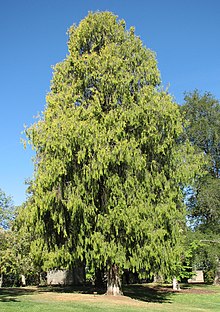
Cupressaceae is a conifer family, the cypress family, with worldwide distribution. The family includes 27–30 genera, which include the junipers and redwoods, with about 130–140 species in total. They are monoecious, subdioecious or (rarely) dioecious trees and shrubs up to 116 m (381 ft) tall. The bark of mature trees is commonly orange- to red- brown and of stringy texture, often flaking or peeling in vertical strips, but smooth, scaly or hard and square-cracked in some species.
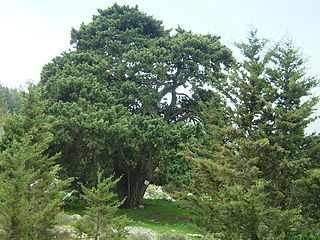
Cupressus is one of several genera of evergreen conifers within the family Cupressaceae that have the common name cypress; for the others, see cypress. It is considered a polyphyletic group. Based on genetic and morphological analysis, the genus Cupressus is found in the subfamily Cupressoideae. The common name "cypress" comes via the Old French cipres from the Latin cyparissus, which is the latinisation of the Greek κυπάρισσος (kypárissos).

Hesperocyparis macrocarpa is a coniferous tree. It is commonly known as the Monterey cypress and is one of several species of cypress trees endemic to California. In New Zealand, where it is also widespread, it is simply known as "macrocarpa".

Chamaecyparis thyoides, a species of Cupressaceae, is native to the Atlantic coast of North America and is found from southern Maine to Georgia and along the Gulf of Mexico coast from Florida to Mississippi. It is one of two species of Chamaecyparis found in North America. C. thyoides resides on the East Coast and C. lawsoniana can be found on the West Coast. There are two geographically isolated subspecies, treated by some botanists as distinct species, by others at just varietal rank: Chamaecyparis thyoides thyoides and Chamaecyparis thyoides henryae (H.L.Li) E.Murray The species grows in forested wetlands where they tend to dominate the canopy. The trees are associated with a wide variety of other wetland species because of their wide north-south range. The remaining populations are now found mostly in remote locations that would be difficult to harvest, so its popularity as a source of lumber has decreased.

Cupressus dupreziana, the Saharan cypress, or tarout, is a very rare coniferous tree native to the Tassili n'Ajjer mountains in the central Sahara desert, southeast Algeria, where it forms a unique population of trees hundreds of kilometres from any other trees. There are only 233 specimens of this endangered species, the largest about 22 m tall. The majority are estimated to be over 2000 years old, with very little regeneration due to the increasing desertification of the Sahara. Rainfall totals in the area are estimated to be about 30 mm annually. The largest one is named Tin-Balalan is believed to be the oldest tarout tree with a circumference of 12 meters or 36 feet.

Cupressus arizonica, the Arizona cypress, is a North American species of tree in the cypress family Cupressaceae, native to the southwestern United States and Mexico. Populations may be scattered rather than in large, dense stands.

Cupressus bakeri, reclassified as Hesperocyparis bakeri, with the common names Baker cypress, Modoc cypress, or Siskiyou cypress, is a rare species of cypress tree endemic to a small area across far northern California and extreme southwestern Oregon, in the western United States.

Cupressus goveniana, now reclassified as Hesperocyparis goveniana, with the common names Californian cypress and Gowen cypress, is a species of cypress, that is endemic to California.

Cupressus guadalupensis, the Guadalupe cypress, is a species of cypress from Guadalupe Island in the Pacific Ocean off western North America.

Cupressus lusitanica, ; cedro blanco means white cedar and is also known as Mexican white cedar or cedar-of-Goa, is a species of cypress native to Mexico and Central America. It has also been introduced to Belize, Costa Rica and Nicaragua, growing at 1,200–3,000 metres (3,900–9,800 ft) altitude.
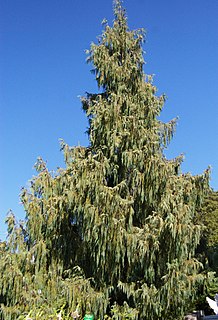
Cupressus cashmeriana, the Bhutan cypress or Kashmir cypress, is a species of evergreen conifer native to the eastern Himalaya in Bhutan and adjacent areas of Arunachal Pradesh in northeastern India. [ Now in vulnerable category, IUCN list retrieved in 2006 ]. It is also introduced in China and Nepal. It grows at moderately high altitudes of 1,250–2,800 metres (4,100–9,190 ft).
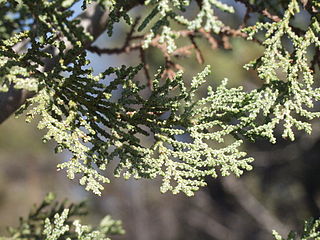
Cupressus macnabiana is a species of cypress in western North America.

Calocedrus macrolepis is a conifer native to southwest China, northern Vietnam, northern Laos, extreme northern Thailand and northeastern Myanmar.
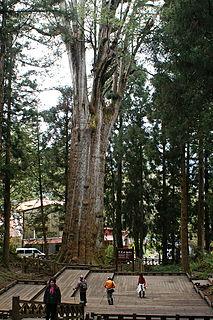
Chamaecyparis formosensis is a species of Chamaecyparis, endemic to Taiwan, where it grows in the central mountains at moderate to high altitudes of 1000–2900 m. It is threatened by habitat loss and over-cutting for its valuable timber.
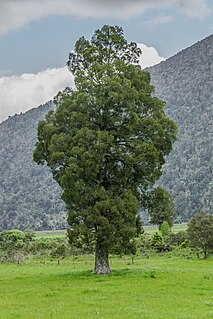
Libocedrus bidwillii, also called pāhautea, kaikawaka or New Zealand cedar, is a species of Libocedrus, endemic to New Zealand. It is in the cypress family Cupressaceae.
Libocedrus chevalieri is a species of conifer in the cypress family, Cupressaceae. It is endemic to New Caledonia, occurring in three small, isolated populations on low mountain summits at 650–1,620 m altitude in cloud forest scrub on serpentine soils. It is threatened by habitat loss.
Libocedrus yateensis is a species of Libocedrus, endemic to New Caledonia, occurring in a few small, isolated populations in low altitude riverside sites at 150–600 m altitude in rainforest scrub. It is threatened by habitat loss.
Retrophyllum vitiense is a species of conifer in the family Podocarpaceae. It is a large evergreen rainforest emergent tree native to Fiji, Indonesia, Papua New Guinea, and Solomon Islands.

Widdringtonia nodiflora is a species of Widdringtonia native to Southern Africa. It usually grows at high altitudes, typically among rocks on mountainsides. Its foliage and wood are highly flammable while its natural habitat is prone to fire. To compensate, the species will coppice from its roots after being burnt down.

Cupressus nevadensis, now reclassified as Hesperocyparis nevadensis, with the common name Paiute cypress, is a species of cypress tree native to a small area in Sierra Nevada of California, in the western United States.
